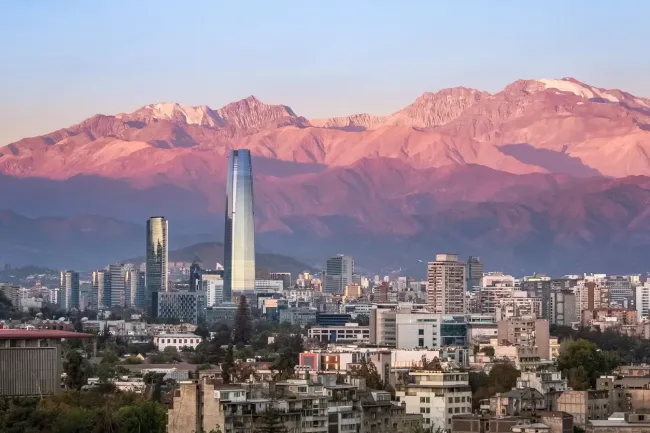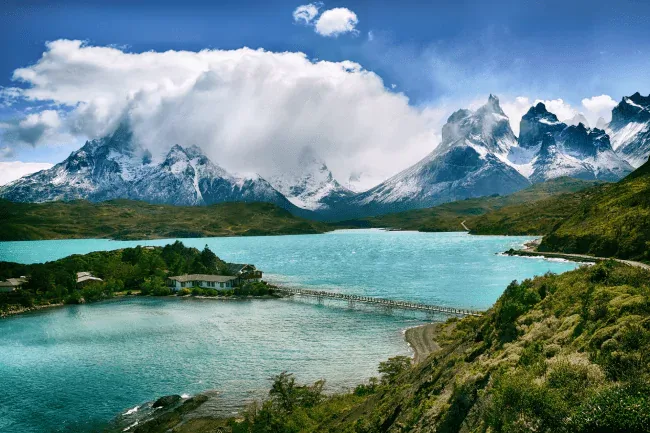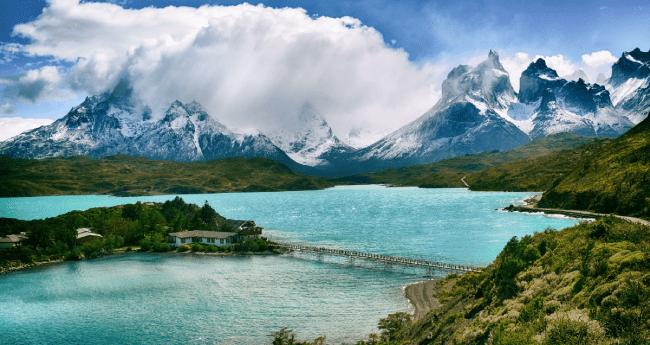
Chile
Welcome to Chile

Not only is Chile a popular adventure destination, but it's also one of the safest countries in South America. In addition, it is the southernmost country in the world, making it the major gateway to exploring Antarctica. Discover Chile and all it has to offer for travelers!
This ultimate Chile travel guide will help you make the most of your Chile trip with practical tips and travel recommendations.
Document checklist for Chile
-
Visa (if applicable)
-
Valid passport (must be valid for at least 6 months from the date of entry and have two blank pages)
-
Sufficient funds to cover your trip
-
Return or onward ticket
Essential Chile travel information
-
Currency - Chilean peso (CLP). $1 is equivalent to approx. CLP 800.
-
Daily budget for 1 person - Allow a daily budget of approx. CLP 56,000 ($70).
-
Languages - The official language is Chilean Spanish. There are a few other languages spoken, such as Mapudungun by the Mapuche population, and Rapa Nui by Easter Islanders. A small minority also speak Aymara. English is commonly spoken in major cities like Santiago.
-
Number of travelers per year - Chile welcomed a total of five million tourists in 2019, ranking 3rd in South America.
-
Socket type - Types C and L, 220V supply voltage and 50Hz.
-
Time zone - Chile Summer Time (GMT-3).
-
Top 3 cities to visit - Santiago, Valparaíso, and San Pedro de Atacama.
-
Top 3 landmarks/monuments - Torres Del Paine National Park, Easter Island, and Punta Arenas (Antarctica).
Visa information for Chile
The Chilean government allows citizens from over 90 countries to enter the country visa-free for tourism, visiting friends & family, or attending conferences or workshops. You can stay for a maximum of 90 days per entry.
However, for some travelers, a visa is required. Learn more about your specific requirements with our handy Visa Checker Tool or continue reading for more info.
The Chile Permanencia Transitoria explained
Some travelers must apply for a “temporary stay permit” called the Chile Permanencia Transitoria. This permit is meant for:
-
Short visits: Such as tourism, sports, medical treatment, family visits, or business networking trips.
-
Crew members: Valid for all types of ships, aircraft, land, or rail transport vehicles belonging to companies engaged in the international transport of passengers and/or cargo.
-
Other: Such as foreigners living in border areas, entertainment personnel, lecturers, consultants, technical experts, and those under conditions of an international treaty with Chile.
The Chile Unique Entry Form (Easter Island) explained
When traveling to Easter Island, which is part of Chile, all travelers have to present the Unique Entry Form on arrival by air or sea. This is a pre-arrival authorization that replaces a visa to visit the island.
The Chile Retirement and Period Income Visa explained
The Chile Retirement and Period Income Visa is a travel authorization that allows foreigners with passive income such as a pension to live in Chile. It’s a temporary residence visa that has a validity period of 12 months. You do not need to have a specific nationality to apply for this visa, as long as you meet the requirements.
Visa difficulty index for Chile
Accessibility: 4/5 Most Chilean visas and permits can be applied for online and are easy to obtain if you meet the requirements. iVisa can assist in obtaining all the above visas for your peace of mind!
However, if you need a regular tourist visa for Chile, you will still need to contact your nearest Chile embassy or consulate to apply.
Time to get your visa: 4/5 Easter Island's Unique Entry Form can be obtained in 4 hours, and Chile's Retirement Visa in 40 business days, making it a pretty efficient process. In spite of this, the process for the Permanencia Transitoria permit takes quite some time, giving Chile four stars out of five for the time to get a visa.
Costs: 4/5 The costs for travel documents are not as high as visas and entry documents to visit other South American countries. In fact, the Unique Entry Form for Easter Island is free, and you’ll only pay for the iVisa processing service.
Check my travel document requirements for Chile
Typical costs and budget for Chile
A guide to what you'll spend on a daily basis traveling through Chile on a mid-range budget.
-
Daily spending - Around CLP 56,000 ($70) per person, per day. This includes:
-
Meals - Expect to spend about CLP 16,000 ($20) for three meals per day.
-
Transport - Depending on your travel plans and standard of travel, local transportation may cost up to CLP 15,000 ($12) including long-distance buses.
-
Hotel - The average hotel price in Chile for a couple is CLP 36,000 ($45). On average, a trip to Chile for two people for one week will cost CLP 641,000 ($800).
Transport and best ways to travel around Chile
There are many ways to get to and around Chile, whether by boat, bus, car rental, or road. Here are some tips for navigating the country safely.
Flying to Chile
You’ll likely fly to the country’s capital Santiago, where Chile’s main international airport, Arturo Merino Benítez International Airport, is located. It is the main hub and connection center in Latin America.
The following airlines fly directly to Santiago:
-
LATAM (to most South- and Central American countries).
-
British Airways (from and to London, 14 hours)
-
Air France (from and to Paris, 14 hours)
-
Iberia (from and to Madrid, 13 hours)
-
KLM (from and to Amsterdam, 14 hours)
-
American Airlines (from and to North America)
-
Qantas (from and to New Zealand and Australia)
Many travelers also cross the borders from Argentina, Peru, or Bolivia by long-distance bus or on tours to visit some of the national parks in the country or border regions.
Arrival and immigration tips for Chile
Santiago Airport is busy but modern, and one of the most efficient in Latin America. A few tips to make the immigration process smoother:
-
Apply for your Chile travel documents in advance to avoid being denied boarding and delays.
-
Every traveler receives an entry receipt, which you must show upon exiting the country. Keep it in a safe place with your passport to avoid losing it, or you may have to pay a fine.
-
Chile is very strict when it comes to importing plant and animal products (basically most food). Any food item must be declared, and most items will be thrown away upon discovery. Please note that you can bring fresh products to Easter Island, but you cannot bring any back to Chile, even though the island is part of the country.
Buses in Chile
There is an expansive bus network in Chile. You can easily get a bus from Santiago Airport to the city and even take a bus directly to other destinations. Long-distance buses can be booked in advance at bus stations, and pre-booking is recommended to get the most comfortable seat.
Metro in Santiago, Chile
The metro system in the capital is pretty efficient, and you’ll need to get a BIP card loaded with a minimum amount of CLP 1,000 to take a trip. It’s preferred over buses as traffic in the city can be a problem.
Domestic flights in Chile
Chile is one of the biggest countries in South America, and that’s why flying domestically is a good solution if you have limited time to explore the country. For example, numerous daily flights connect Santiago with Patagonia and Punta Arenas in Southern Chile, as well as San Pedro de Atacama in north, and central Chile.
Likewise, there is at least one LATAM flight per day to Easter Island, which takes about 5 hours. Due to the popularity of this unique island, it is advised to book well in advance.
Boat and ferries in Chile
Many places in Chile, including Chiloé and the Southern Coast, can be reached by boat or ferry. They are also a great alternative to flying if your destination is a southern port like Puerto Natales or Punta Arenas. Routes in the south are primarily operated by Navimag and Transmarchilay.
Several international cruise lines call at ports, typically starting in Valparaíso, following the coastline to the southern archipelago and the beautiful fjords. Victory Adventure Expeditions and Adventure Associates are some of the main tour companies that offer cruises to Antarctica.
Renting a car and driving in Chile
It is very easy to rent a car or camper van in Chile. An international driving permit, passport, and credit card are all you need to rent a car. A self-drive holiday in Chile is the perfect way to see the country, and highways are generally in good condition.
Safety in Chile
Chile has a very low crime rate and is considered one of the safest countries on the continent. Most crimes are nonviolent and involve things like pickpocketing and theft. There are relatively few violent crimes, but they do occur. Travelers traveling in remote areas or at night should take precautions.
Since October 2019, Chile has been experiencing political instability and civil unrest. There have been mass protests against inequality, the cost of living, and other social issues.
Should you find yourself caught in a protest, it’s best to leave the area as quickly as possible and find a safe spot to wait it out. While most protests are peaceful, conflicts between local authorities and protestors can get violent.
Weather in Chile
In general, Chile is best visited during the summer, between December and February. Warmer temperatures from 15°C (60°F) and 32°C (90°F) ensure that you’ll have easy access to areas that are impassable in winter, and most fun events take place during this time. The rainy season runs from the end of May until October.
November to March is the best time to visit Antarctica when the wildlife is at its busiest, and you’ll benefit from up to 24 hours of daylight!
However, the best time to visit depends on your travel purpose! Spring (September to November) and Fall (March to May) are some of the best times to hike in Torres Del Paine national park and the rest of Patagonia. Since they're the shoulder seasons, there are fewer crowds and gorgeous spring blossoms or fall colors are abundant.
Must do and see in Chile
Don’t miss these awesome sights on your holiday to Chile:
-
Easter Island - Also called Rapa Nui. Besides the mysterious Moai heads and great cultural significance, Easter Island also offers a wealth of natural riches with extinct volcanoes and a rugged coastline of cliffs, beaches, and hidden bays.
-
Hike in Patagonia - This unique region in southern Chile and Argentina is a patchwork of terrains and microclimates that challenge and surprise hikers of every skill level. Some of the most famous hikes are the W-trek in Torres del Paine national park and Lago del Desierto.
-
Cruise to Antarctica - The voyage from Chile to the Antarctic will take you through the Chilean Fjords passing by Cape Horn before venturing into the (in)famous Drake Passage. An experience of a lifetime!
-
Stargazing in the Atacama Desert - Chile's Atacama Desert is one of the country's most fascinating destinations, featuring salt flats, high-altitude geysers, softly smoking volcanoes, and lunar rock formations. It is also considered one of the best places on Earth for stargazing, with some of the clearest skies and most advanced observatories.
-
Wine tasting - The Casablanca Valley near Valparaíso offers the best vineyards that produce some of the most outstanding wines in the world.
-
Discover the marble caves - The Marble Caves lie on the Chile-Argentina border on a peninsula made of solid marble, creating some of the most gorgeous effects you’ll ever see. Taking guided tours by kayak is possible through the naturally-carved archways of General Carrera Lake.
-
Street art in Valparaíso - Graffiti in Valparaíso began as a form of protest against the dictator Augusto Pinochet. At that time, self-expression, including art and painting, was suppressed. After the dictatorship ended, government officials made street art legal in the city, which flourished.
-
Explore the Chilean fjords - The southwest coast is home to the magnificent Chilean fjords, starting in the Reloncavi Sound near Puerto Montt and finishing at the Cape Horn. One of the best ways to visit the Chilean fjords is by a cruise in three or four days.
Typical Chile food to try
Here are a few things to try while on a trip to Chile:
-
Pastel de Choclo: casserole made of corn with meat stuffing.
-
Empanadas: the Chilean version of this pastry is larger than the Bolivian and Argentinian counterparts, filled with meat or cheese.
-
Asado: for meat lovers! A barbecue of beef, pork, or chicken.
Vaccine information for Chile
It's important to know what routine vaccines and COVID-19 measures are required to enter Chile before booking your trip. We advise you to check the CDC website for more info about all vaccine requirements and recommended medicine lists.
Visiting Easter Island from Chile
Most travelers are captivated by Easter Island's timeless moai (also known as Isla de Pascua in Spanish or Rapa Nui in its native tongue) and striking, seemingly barren landscapes, which hint at a turbid, fascinating history.
Tourists to Chile are often attracted to the astoundingly remote Easter Island.
The only way of traveling to Easter Island is by plane. It is common for flights to be delayed due to high winds, so you may need to stay flexible if you have to wait a day in Santiago or on the island. LATAM is the only airline and takes about 5 hours to get to the island. Make sure to book ahead, as flights can get expensive and fill up quickly.
The annual Tapati Rapa Nui festival takes place on Easter Island during the first two weeks of February, which is a popular time to visit. However, another great time to go is September or March, as temperatures are pleasant and there are fewer people.
Don’t forget to apply for the Chile Unique Entry Form, mandatory for all visitors to the island, with iVisa.

 United Kingdom
United Kingdom
 United States
United States
 Japan
Japan
 Canada
Canada
 Mexico
Mexico
 Vietnam
Vietnam
 India
India
 Brazil
Brazil
 Australia
Australia
 New Zealand
New Zealand
 Indonesia
Indonesia
 Thailand
Thailand


